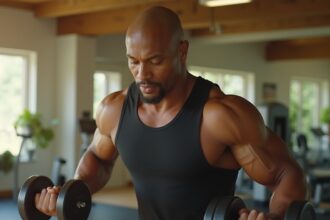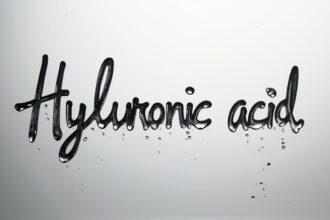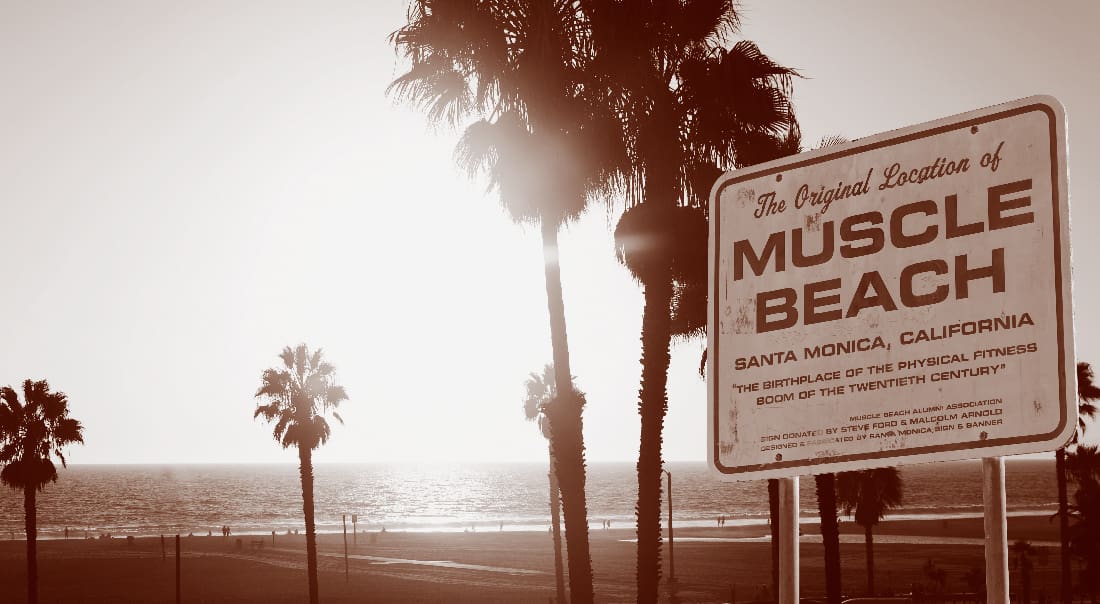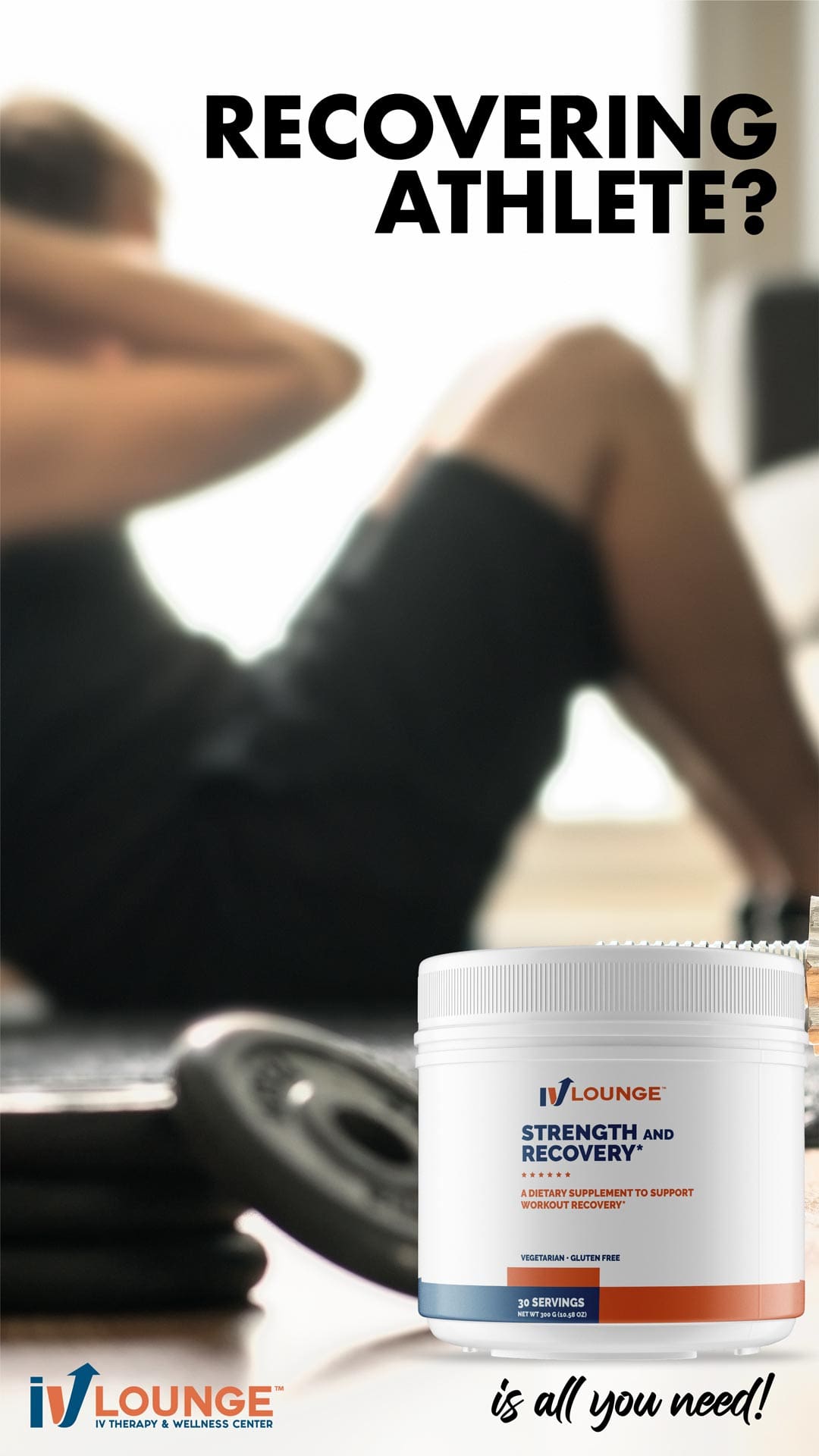“This is where my sport started.”
If you go to the 1700 Ocean Front Walk, Santa Monica, California, you will see nothing more than a swath of beach located just south of the historic Santa Monica Pier. But every weightlifter and strength athlete can point to that spot and state – the original Muscle Beach.
This is a place where bodybuilding and weightlifting exploded in popularity. It was more than just a place – it was a movement. So many different events and people made this particular site the founding place for modern bodybuilding and weightlifting.
The 1930s – Humble Beginnings
In 1933, the Santa Monica Recreation and Parks Department was looking to refurbish its beachfront. One of the early advocates for a “playground on sand” was Kate Giroux, a local playground instructor. She wanted an open space for less fortunate children to be able to play and work out.
At that very same time, against the backdrop of the Great Depression in the United States, President Franklin Roosevelt formed the Works Progress Administration (WPA). The WPA’s goal was to create local construction projects to combat the epidemic of unemployment.
The Santa Monica Project
The Santa Monica beachfront project was a perfect fit for this program. By 1934, it created the “playground on sand” on Santa Monica Beach. It had parallel bars, horizontal bars, rings, a weightlifting pen, an equipment shed, and a tumbling platform. Other additions to the recreational area included volleyball courts, tables for chess, and ping pong.
Soon, the athletic equipment became the star attraction. The success of the venue was immediate as it attracted gymnastics athletes, stuntmen from the Hollywood studios, acrobats from the nightclub circuits, wrestlers, and weightlifters.
Besides the thoughtful installation of the athletic equipment and the near-perfect year-round weather, one of the other driving forces of this near-instant success was the number of gyms and athletic facilities in the Los Angeles area that were closed due to the 1933 Long Beach earthquake.
The earthquake forced the closure of many of these facilities and school gyms. The athletes, without an athletic home, now had a brand-new facility that was outdoors. Soon, there were weekend exhibitions and competitions, and throngs of fans attended these events.
The Rising Popularity of Muscle Beach
There were strength and wrestling competitions, as well as beauty contests and beach play. There were also stunts that became unique to this beach – the creation of human pyramids, the tossing of beautiful women between strong, muscular men, and a mixture of strength and fitness that had never been on public display before.
People came to see the “muscle men” at the beach, thus earning the name “Muscle Beach.” (This was not to be confused with “Brain Beach,” which was located on the north side of the Santa Monica pier and was a place of congregation for UCLA students.)
By the end of the 1930s, strength sports started to dominate beach activities as weightlifters started to bring their own barbells. Gymnasts worked with the city to expand the facilities, with more bars and rings being added, as well as a gymnastics platform.
As an extension of this success at the beach, private gyms started to open in the neighboring blocks as newcomers to strength sports wanted to possess the same skills (and bodies) as the participants at the beach.
In 1939, the bodybuilder Vic Tanny opened a gym two blocks from Muscle Beach. However, unlike other private gyms that were aimed toward men and serious athletes, Vic started a program aimed and priced for the working man and his family. This fledgling program later developed into a 100-gym network that is now a part of Bally Fitness.
Similarly, fitness guru and bodybuilder Jack LaLanne saw firsthand the success of Muscle Beach as its regular visitor. He saw it as a validation of his belief that there was a demand in the United States for fitness and a healthy lifestyle. He opened his first gym in Oakland, California in 1936.
The 1940s – MORE SUCCESS
World War II slowed down activities at Muscle Beach for a while. However, this place remained a popular social gathering spot, especially for the servicemen who were stationed in and around the Los Angeles area.
Women Took The Lead
Like many reflections of the war effort at home where women came to the fore, it was no different at Muscle Beach. One of those women who broke out as a leader and figure of the sport was Abbye “Pudgy” Stockton, later known as the “Queen of the Quads.”
Initially taking up calisthenics for weight control, she and her boyfriend – later husband – Les, began performing gymnastics and acrobatics routines on the beach. At 5’2 and 115 pounds, she wowed the crowds with her feats of strength, such as supporting her 180-pound husband, Les, over her head in a hand-to-hand stand.
Not only was Pudgy a popular figure at the beach, but she became a media star. She was featured in newsreels and national magazines, such as Life. In 1944, she began writing a magazine column aimed at women’s weight training and fitness.
Later, she became involved in the organization of weightlifting contests for women, including the first Amateur Athletic Union (AAU) sanctioned competition in 1947 in Los Angeles. Pudgy Stockton also set trends in other areas of sport, such as costume and appearance.
With the help of her mother, she basically tore apart and then re-sewed a one-piece bathing suit. She created an original “fitness” garment that, by all appearances, was a two-piece bathing suit. That was another part of the evolution and revolution of Muscle Beach: the display of the body in public.
Clashing with Tradition
These strength athletes were free from many of the conscripts of the social norms with their public displays and routines. What they wore to show off their near-perfect forms was pushing that envelope even further.
Although their fashions and attitudes were widely embraced, they were starting to fall into conflict with what was, basically, a conservative beach community.
The 1950s – TIME OF STRIFE AND CHANGE
The 1950s saw the height of the popularity of Muscle Beach. What started 20 years before as a beachside improvement aimed at the community at large was now the world-famous venue for strength athletes. The number of participants was larger than ever as fitness and weight training became more popular.
This trend was aided by the migration of the population from east to west following WW II. The migration was also present in the fitness industry. The East Coast-based barbell companies, such as Bob Hoffman’s Atlas Barbell and Joe Weider’s Weider Barbell Company, sent their sales reps to the West Coast along with their public relations writers.
Each of these companies had their own fitness magazines (Hoffman had Strength & Health, and Weider had Muscle Power), and each created an almost idealized vision of Muscle Beach for their readers. Many of their readers were used to working out indoors in the wintery north and certainly not on the beach in the perfect weather of California.
The Muscle House By The Sea
One by one, bodybuilders of acclaim in the east were making their way west. Many of them found the perfect living situation in what was later to be called “The Muscle House” or “Muscle House by the Sea.”
Located only several feet away from Muscle Beach, this popular boarding house was owned by Joy Crettaz, an older single woman who had a soft spot in her heart for bodybuilders. She charged her tenants only $100 a month and provided three meals a day, all vegetarian courses.
As for sleeping accommodations, bodybuilders were jammed 12 to a room, adding to their Spartan and focused existence. And, as former tenants recall, the “aroma” of the housing situation was such that the windows were always open.
Nonetheless, some of the greatest strength athletes called the Muscle House home. Amongst them was Steve Reeves, who, with his 29” waist and 51” chest, became best known for his main role in the Hercules film.
Other notable names included Jake Dellinger, George Eiferman, and Dave Draper. Probably the most famous resident was Vince Edwards, a standout athlete and dedicated weightlifter who later went on to television fame as Dr. Ben Casey.
Bill “Peanuts” West arrived at Muscle House weighing in at 85 pounds and eating a peanut-focused diet to gain weight (Joy gave him his nickname). He eventually developed into one of the great powerlifters and instructor to powerlifters. To this day, Bill West is referred to as “the Godfather of Powerlifting.”
Overstaying the Welcome
As more and more bodybuilders moved to the epicenter of their sport, the local fandom also exploded as weekend exhibitions would draw as many as 10,000 people to Muscle Beach. This stunning popularity began a love/hate relationship with the city of Santa Monica.
Although the city appreciated the number of visitors to the beach, they nonetheless had complaints from shop owners and citizens about the behavior and dress code of the strength athletes and their fans. To many in this conservative community, the weightlifters and their followers were “bums” and “weirdos.”
Their lifestyle, which focused on the beach, was certainly counter to the concept of having a 9-to-5 job and “working for a living.” The culmination of these complaints and the clashing of cultures were building to a point where the city was looking for an excuse to curb the activities of Muscle Beach.
In December 1958, they found that excuse. In an apartment directly adjacent to Muscle Beach, four weightlifters were found with underage girls. The story was sensationalized in local news, and although no charges were ever brought against the weightlifters, the incident was enough to bring the city to action.
Tearing Down The Muscle Beach
One morning, at dawn, a bulldozer cleared the beach of all the athletic equipment and signage. There was no edict by the city to commence this action, nor was there any warning of such an action or even a public hearing.
The bulldozer’s blade was the singular, devastating move that brought about the end of Muscle Beach. Remarkably, that same morning, and for decades of mornings to follow, gymnasts still showed up at that exact spot for their workouts.
Move to The Dungeon
The banishment of the strength athletes, especially the weightlifters, from Muscle Beach was barely a speed bump in the onward progression of the sport and for those particular athletes. For a while, they moved their activities to Vic Tanny’s gym, in the basement of a 7,000-sq. ft. building that was a former USO club.
In the weightlifting world, this was called “The Dungeon.” The facility also lived up to its name in another way – it was way past its prime. Vic Tanny sold the place, and the new owners let the condition of the facility slide, so all that remained were four damp concrete walls and weights.
Still, that was enough for some of the greatest bodybuilders in the world at the time, like George Eiferman, Dave Draper, Bill McArdle, and Chuck Ahrens. While it was the new “home,” what was missing from their routine was the beach, which was more important than they realized.
The serious lifters had a weekly routine. They performed not only heavy gym workouts but also the exercises that were always performed at the beach. These exercises may have remained in their routines, but the beach was gone.
To the lifters, that meant that their routine was changed, and they weren’t happy about that. Eventually, the elite weightlifters moved from “The Dungeon” and followed their brother lifters two miles south to “The Pit.”
The Rise of the Pen
In 1951, the Los Angeles Recreation and Parks Department built a weightlifting pen on the beach near Winward Avenue in the Venice community. This was less than two miles south, down the Ocean Walk from Muscle Beach.
The site was modest in both size and facility, but it was made specifically for weightlifters. This new site became known as “The Venice Pen,” “The Pen,” or “The Pit.” Eight years after its founding, the displaced weightlifters from Muscle Beach made “The Pit” their new home.
It was an easy transition for them. Not only was the venue sport-specific, but the Venice community was far more accepting of weightlifters and the weightlifting community. However, there was really no comparison between Muscle Beach and the Venice Pen. In terms of installed equipment and the size of the beach area that comprised the workout area, the Pen was much more “modest.”
What it did have going for it was a specific site for strength athletes located within a community that embraced bodybuilders. Venice wanted to be “the new Muscle Beach.” Within a year, the last of the loyal holdouts abandoned Santa Monica and moved to The Pen. The tribe was back together.
The 1960s – THE RISE OF VENICE PEN
Once the bodybuilders claimed Venice as their new home, the gyms and some particularly market-savvy entrepreneurs soon followed. One of these key figures was Joe Gold. He was a local bodybuilder, best known today as the founder of Gold’s Gym.
Joe Gold made significant contributions to the sport, to the point of being called “The Father of Body-Building.” As a teenager in Los Angeles, Joe became curious and very serious about bodybuilding. His curiosity about the sport was evident from the type of equipment that he used in his workouts.
First, he used weights attached to broom handles, an idea that he got from his sister-in-law, who used such a contraption for her own arm-strengthening exercises. Later, he made an array of specific equipment for bodybuilding from welded scrap metal with help from his brother Robert, who owned a scrap yard and was a welder.
Although the equipment could be described as “grimy,” these innovations began a revolution. In terms of working out with machines and weights, the movement continues today with the modern gym. As a frequent visitor to Muscle Beach, Joe also followed the crowd to Venice.
In 1965, he opened Gold’s Gym. This became the “Mecca of Body Building”. Although this was his own description, it was entirely appropriate to its context at the moment. At Gold’s, the best bodybuilders on the scene worked out with the homemade equipment and the sarcastic encouragement of Joe Gold himself.
Arnold Schwarzenegger’s Rise to Fame
The athletes were a veritable “Who’s Who” of the sport. They included the likes of Dave Draper and the most renowned athlete in the sport, Arnold Schwarzenegger. As a young boy in Austria, Arnold dreamed of coming to America.
He saw bodybuilding as his ticket to this dream. The final destination of his dream was moving to Venice, California, and Gold’s Gym. Working with Joe Gold as a mentor and Joe Weider as his personal trainer, Arnold developed into the greatest bodybuilder in the history of the sport.
One of the greatest artifacts of this sport to come from Venice was the 1977 movie Pumping Iron. The movie featured Arnold in his quest for his sixth consecutive Mr. Olympia title. He faced stiff competition from Lou Ferrigno, who was, physically, the largest bodybuilder at that time.
Also playing starring roles in the movie were Gold’s Gym, bodybuilding as a sport, and Venice as the cultural and intellectual center of the sport. The man behind this film was the new owner of Gold’s Gym, Ken Sprague.
The 1970s – HOLLYWOOD FAME
After Joe Gold sold the gym in 1970, the facility languished. In 1971, Ken, a gym member, stepped forward to become the third owner of Gold’s Gym. Ken was a true entrepreneur and marketer.
One of his early initiatives led to Gold’s Gym becoming the first gym to create and sponsor programming for bodybuilding competitions. Later, Ken would leverage his connections and his Hollywood contacts to create Pumping Iron.
Pumping Iron
One of his Hollywood contacts of particular importance in the film was George Butler, a photographer and documentarian. The resulting success of the movie Pumping Iron remains with us today.
It began the movie career of Arnold Schwarzenegger, who would become the top box-office draw in the 1990s. It gave Lou Ferrigno his part in the Hulk TV series, and it established Gold’s Gym as the most famous gym in the world.
Many credit the film with the beginning of the fitness craze of the 1980s. Gyms became not only the latest social gathering spot but also an integral part of one’s life.
The film also serves as a time capsule for the sport. It showed Gold’s Gym in all of its unfinished glory. It did the same for “The Pen” in some brief shots where Arnold is on the beach, spotting for one of his training partners. Both the gym and the beach seemed so primitive and raw.
Yet, these were exactly where you wanted to be if you were serious about the sport. If nothing else, these images make you appreciate how far the sport and the athletes have come. There is no denying the success of this sport today, but these early Spartan conditions show the purity of the sport and the drive of these athletes.
The Birth of the New Muscle Beach
History is something that is easily misappropriated. Venice could have claimed the title of “Muscle Beach” because it became everything that Muscle Beach was and more. It effectively completed the chapter that started in the sand south of the Santa Monica Pier.
However, there is a multi-generational recognition and an honor of history within the ranks of bodybuilding. The recognition comes from its former champions or, in this case, the place of origin. That’s why Venice was a truly worthy successor of the original Muscle Beach.
The 1980s and 1990s – THE FINAL RECOGNITION
In 1986, the Department of Recreation of the City of Los Angeles sought to formally rename The Pen “Muscle Beach Venice.” But to do so, they wanted the approval of someone who would have the “authority” of the originators.
They approached Armand Tanny. He was the brother of Vic Tanny, one of the “founders” of Muscle Beach and one of the first to open a gym near the beach in 1939. With that familial link and his own credentials as a Muscle Beach regular and a former bodybuilding National Champion, Armand wrote a letter to the City, giving it the blessing that it wanted.
The New Muscle Beach
Thus, in 1987, “Muscle Beach Venice” was named, and the original Muscle Beach was preserved, at least in name. However, it would not be until 1990 that the Venice Pen would be renovated or, rather, completely remade.
It is a rare thing when a “wrong” is righted or when an object of history is put back in its rightful place. For the original Muscle Beach, that is exactly what happened. In 1989, the city created a “family version” of a beach fitness facility on the original Muscle Beach site.
There were rings and parallel bars, just like the original equipment. But, the centerpiece of this area refurbishment is a toddler playground. It was a “placeholder,” just to be sure the city wouldn’t change its mind. However, it was also a message that they did not want the strength athletes to return to this beach birthplace.
Ten years later, as part of a large community investment in the beach area, $200,000 was committed for equipment to build Muscle Beach just as it was in 1934. This project followed the specifications of the original WPA plans to the inch. What you see on the beach today was what started Muscle Beach.
Modern Times
Moving further south down the beach walk, the City created the modern Pen at 1800 Ocean Front Walk. The facility is complete with bleachers for fans and a giant concrete barbell on its roof. A day pass is $10, and an annual pass is $170.
For that, you get to work out on various pieces of equipment in an enclosed space that is dedicated to the strength athlete. Behind the Pen is Venice Beach, with several pieces of gymnastic equipment in the sand.
Although this area is not to the scale of the old Muscle Beach, it nonetheless is an homage to the beach workout spirit. Famous names in the sport still come to The Pen. Even if they do not work out, they participate as competition judges or just visit the latest generation of the sport.
Arnold, for example, did a photo shoot with current athletes at The Pen this past June. These legends of the sport are also honored all around The Pen. As members of the Muscle Beach Venice Hall of Fame, they have bronze barbells on plaques fixed at the base of the enclosure. Amazingly, Arnold is not among these names.
If you are looking for crowds reminiscent of the original Muscle Beach of the 1950s, visit The Pen on holiday weekends during the summer. Here, you will find thousands of fans crowding the Venice Beach Walk.
Honoring the History for a Bright Future
All the major sports honor their history. Whether it be championships, records, or unique accomplishments. Bodybuilding is no different. Within a two-mile drive between the Santa Monica Pier and Venice Boulevard in Venice, you will find the very origin of this sport as well as its present incarnation.
Along the way, you will see the original Gold’s Gym. Although the building is now abandoned, the original signage remains. Gold’s Gym is a site that ESPN lists in its Top 100 Sports Venues, along with the base of The Pen, where the athletes who built this sport became immortal.
In the wave of fitness and personal improvement, with gyms that are bright with light and stainless steel, never lose sight of the fact that this was once a much more humble sport. Back then, it was popular among men and women who had just the passion and the drive. It all started on these sands…







